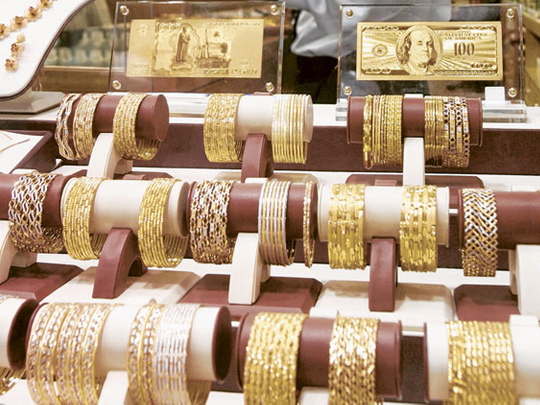
London: Gold edged up yesterday, set for its biggest weekly gain in a month after US data showed the economy had generated more jobs in the last three months than previously thought but not fast enough to cut unemployment, which weighed on the dollar.
US nonfarm payrolls rose 103,000 last month, compared with forecasts for a rise of 60,000, while revisions to data for July and August showed 99,000 more jobs were added in that time than initially reported, while the unemployment rate stood unchanged at 9.1 per cent, the Labour Department said.
Gold rose 0.2 per cent to trade at $1,652.59 (Dh6,065) an ounce by 1325 GMT, having touched an intraday high of $1,665.99 earlier, while US December gold futures were up 0.1 per cent at $1,655.60.
"To me, [the data] doesn't change the interest-rate environment for gold, which is still very positive, with more gains ahead.
"And from where we are in real interest rate terms, you should see gold returns of 30 per cent year-on-year," said Deutsche Bank analyst Michael Lewis, whose bank expects an average gold price of $1,750 an ounce in the last quarter of this year.
"I don't think the payrolls number changes that backdrop, which still looks quite supportive, but I wouldn't be surprised if gold came off a little bit, but I think it's probably more important for equity markets and industrial metals."
Platinum rose by as much as 2.0 per cent on the day to a session high of $1,536.24, to later trade at $1,526.25, up for a third consecutive day in its longest stretch of gains in two months.
Slowing economy
Platinum has lost more than 16 per cent over the last month and the price has tumbled to its lowest in nearly two years, after evidence of a slowing Eurozone economy, upon which platinum relies for industrial demand, raised fears of another slide into recession.
Palladium rose by 0.3 per cent on the day to $604.47 an ounce, having fallen earlier by as much as 1.7 per cent, but was still set for its fifth consecutive weekly loss.
European shares rose to their highest in five weeks following the US jobs data. This added to the optimistic tone already underpinning the equity markets, after the European Central Bank's decision on Thursday to leave interest rates unchanged at 1.5 per cent, but anchor short-term borrowing costs for banks and sovereign borrowers by providing extra liquidity.
The gold price rose by 1.8 per cent last week, its largest weekly gain since September, buoyed by a surge in consumer demand that materialised with last month's 10.9 per cent drop below $1,700 an ounce.
"What you're seeing is demand for physical metal continues to be very, very strong. China was off all week.
"They'll be back this week and I presume demand will only increase, so I think that is why the market has held so nicely around this $1,600 mark," said MKS Finance head of trading Afshin Nabavi.
"The market was extremely bearish in the dollar and extremely bullish on precious.
"It's not a one-way street all the time. We needed a correction and don't forget we are talking about less than $300 in a commodity that was priced close to $2,000," he said.
Correction
"I still wouldn't mind seeing it have a bit more of a correction on the downside first to clean up some of the spec length over the market and towards the end of the year, it will be closer to $2,000 again," he added.
Premiums for physical delivery in Asia have risen to their highest levels since the start of the year, reflecting an increase in demand for metal in a key-consuming region, with jewellers in China, Indonesia, Vietnam and top consumer India entering the market.
Following an outflow of nearly half a million ounces of gold from global exchange-traded funds in September, when the price fell by more than 20 per cent from a record $1,920.30, ETFs have recovered nearly a quarter of that metal as investors have also taken the opportunity to buy at lower levels.
In other precious metals, silver was down by more than half a per cent at $31.72 an ounce.










